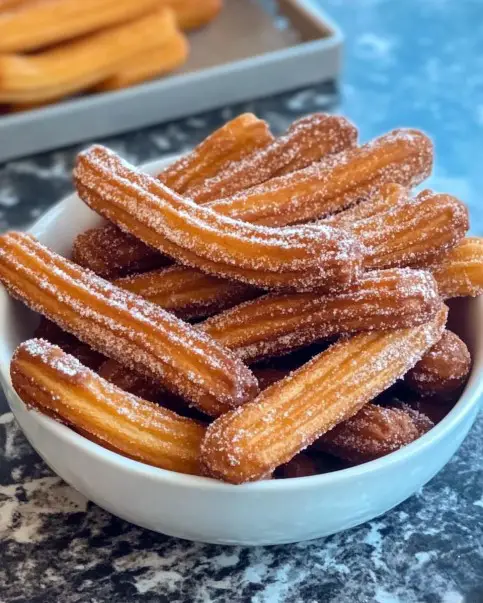The Origins of Churros
Churros have a long and somewhat debated history, with different theories about their origins. One popular belief is that churros were inspired by a Spanish dish called “frying dough,” which was known in Spain as “churro,” a term that is still used to describe the treat today. These early churros were likely made by Spanish shepherds in the mountains, who lacked ovens to bake bread. Instead, they would create simple dough, fry it in hot oil, and enjoy it as a quick, portable snack during their long, solitary hours in the mountains.
Another theory posits that churros were introduced to Spain by Portuguese explorers, who may have encountered the concept of deep-fried dough in China. The Chinese “youtiao,” a deep-fried dough stick often eaten with soy milk, bears a striking resemblance to churros and could have inspired their creation in the Iberian Peninsula. Over time, churros began to evolve and take on the sweet, spiced form we know today.
Regardless of their precise origin, churros soon became popular throughout Spain, Portugal, and the Spanish colonies, particularly in Latin America, where they became a common breakfast or afternoon snack, often enjoyed with hot chocolate. Today, churros are enjoyed in various forms worldwide, from the traditional fried version to creative, modern adaptations.
The Essential Ingredients
The beauty of churros lies in their simplicity. The dough itself is made with just a few basic ingredients: water, sugar, butter, salt, and flour. These ingredients come together to form a rich, smooth dough that is firm enough to hold its shape when piped into hot oil but soft enough to melt in your mouth after frying.
- Water: Water is the base of the dough, helping to hydrate the flour and bind the ingredients together. The warm water in this recipe aids in the process of dissolving the sugar and butter, ensuring a smooth mixture.
- Sugar and Vanilla Sugar: These ingredients are responsible for the sweetness that makes churros so irresistible. The vanilla sugar also adds a subtle aromatic depth that enhances the flavor profile of the churros.
- Butter: Butter contributes to the dough’s richness and flavor. It also adds to the crispy texture of the churros once fried.
- Flour: All-purpose flour is the primary structure of the dough. When mixed with water, it absorbs moisture and forms a thick paste that becomes the light, fluffy interior of the churro once fried.
Frying and Shaping the Churros
Frying churros is where the magic happens. The dough is piped into hot oil, where it quickly puffs up and turns golden brown. The key to achieving that perfect crispy exterior and soft, tender interior lies in the temperature of the oil. Too hot, and the churros will cook too quickly on the outside, leaving the inside raw. Too cool, and the dough will absorb too much oil, resulting in soggy churros. The oil should be maintained at around 350°F (175°C), allowing the churros to cook evenly and achieve their signature crispness.
Shaping the churros is another critical element in their creation. A star-shaped piping tip is often used to create the iconic ridges along the churro, which not only gives them a visually appealing look but also contributes to their texture. These ridges help the churros fry more evenly and provide extra surface area for the cinnamon sugar coating to adhere to after they are cooked.
The Cinnamon Sugar Coating and Dipping Sauces
Once the churros are fried and drained of excess oil, they are traditionally rolled in cinnamon sugar. The cinnamon sugar adds sweetness and warmth, making each bite an aromatic, flavorful experience. The crunchy exterior combined with the sweet coating makes churros incredibly addictive.
Churros can be served in a variety of ways, with the most popular accompaniments being chocolate sauce and hot chocolate. The rich, velvety chocolate sauce is often used as a dip, complementing the warmth and sweetness of the churros. The dipping experience enhances the pleasure of eating churros, with the contrast of temperatures between the hot churros and the cool, creamy sauce creating an indulgent treat.
In some regions, churros are served with other types of dips, such as caramel or dulce de leche, offering different flavor profiles to suit a variety of tastes.
Variations of Churros Around the World
While the basic concept of churros remains the same, they’ve been adapted in various ways across different cultures. In Spain, churros are often served with a thick cup of hot chocolate for dipping, creating a rich, satisfying breakfast or dessert. Spanish churros tend to be thinner than those in other countries, and they may be served in small individual pieces or long sticks.
In Mexico, churros are often enjoyed as a street food and may be filled with chocolate, caramel, or cajeta (a sweetened caramelized goat’s milk spread). These stuffed churros have become a popular variation, offering a delightful surprise of sweet filling with every bite.
In Latin America, churros are commonly enjoyed as a snack during celebrations, festivals, or as part of a festive breakfast. Churros in these regions might also be served with a variety of fillings, including cream, fruit, and dulce de leche.
In the United States, churros are often found at fairs, amusement parks, and street food stalls, where they’re served fresh, hot, and dusted with sugar or cinnamon sugar. They have also made their way into modern cuisine, with some restaurants offering churros stuffed with ice cream or topped with whipped cream, chocolate chips, and sprinkles.
Why Churros Are So Popular
Churros’ enduring popularity can be attributed to several factors. First, their crispy texture combined with their sweet, comforting flavor makes them universally appealing. They are simple to prepare yet incredibly satisfying, making them an ideal treat for any occasion. Additionally, churros are highly customizable, with different dips, fillings, and toppings allowing for endless variations.
Another reason for their widespread popularity is their cultural significance. Churros are often associated with celebrations, family gatherings, and street food festivals, adding a sense of nostalgia and enjoyment to every bite. Whether enjoyed on a lazy Sunday morning, at a bustling market, or as a dessert after a festive meal, churros evoke feelings of warmth and joy.
Conclusion: A Timeless Treat
Churros have certainly earned their place as one of the most beloved sweet treats worldwide. From their humble beginnings as a practical snack for Spanish shepherds to their widespread popularity at fairs and food stalls around the world, churros have stood the test of time. Their simple ingredients, ease of preparation, and satisfying texture make them a perfect choice for any occasion, whether enjoyed as an afternoon snack, a breakfast indulgence, or a festive dessert. The combination of crispy dough, warm cinnamon sugar, and chocolate dipping sauce creates a treat that’s impossible to resist.
So, whether you enjoy churros on their own or dipped in chocolate sauce, this timeless dessert continues to bring joy to people across cultures and generations. It’s no wonder that churros have become synonymous with happiness, celebration, and indulgence, making them a must-try for anyone with a sweet tooth.






